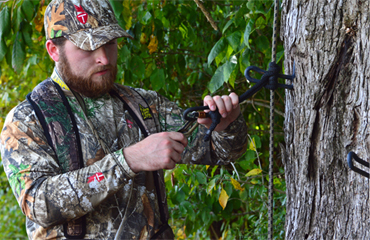Photo: Along with proper safety gear, knowing handhold and climbing techniques greatly reduce risk of treestand accidents.
Take five minutes to teach these climbing principals to your kids and it will help them climb trees safely for the rest of their lives.
I learned these fundamentals in mountaineer training classes back in my younger days, and they have served me well while chasing whitetails and climbing countless trees over the years.
Rock climbing tips work well for scaling rock walls, rappelling and mountain climbing, but the same principals apply to deer hunters who use tree steps, ladders or climbing sticks.
Aside from not wearing a safety vest, the biggest cardinal sin of climbing is to allow both hands to drop below head level at the same time. Teach your kids to keep their hands high!
Climbers need a solid handhold — preferably two — above their heads at ALL times. In case of a slip, this puts the climber in the strongest possible position to correct the fall, or at least hang on longer until a foothold can be regained.
If a slick, muddy boot were to slip off a tree step, it’s not a big deal if you have good handholds above your head. If both hands are below your head, you have your body’s momentum to deal with, and big problems.
Statistically, getting in and out of stands is where most treestand accidents occur, so you should create something to grab above your head for all phases of the climb.
When setting up my treestands, I bring extra screw-in steps to place in strategic spots above my head, easily reachable and designed for getting in and out of the stand. My feet will never touch these steps, but the steps serve as great handholds, helping me safely maneuver around the tree.
Another valuable tip I learned from mountaineering is that rock climbers keep their bodies as close as possible to the surface they are climbing.
A body that is closer to its points-of-contact (handholds and footholds) reduces stress on the climber’s arms, legs and hands and helps keep gravity from pulling the climber away from the wall.
Keep your chest, pelvis and torso as close as possible to the tree or ladder you are climbing, so gravity won’t get a hold of you as easily. In bulky hunting clothing, it’s not so easy to do, so tell young hunters to focus and take their time.
If you have a rifle or backpack strapped to your back, you are endangering yourself with added weight on the outside of your body pulling you away from the tree. Leave a stout rope on all your treestands to hoist gear, and show young hunters how to use it.
And if the tree you plan to climb is curved, set up your climbing sticks or tree steps on the outer part of the curve so that gravity works for you instead of against you.
In addition to proper climbing techniques, we at Buckmasters highly recommend the use of a lifeline and harness, such as models made by Hunter Safety System. This gives added peace of mind and safety for you and your young hunters.
Editor’s Note: If you have a unique or special tip you’d like to share with Buckmasters fans, please email it to huntingtips@buckmasters.com and, if chosen, we will send you a cap signed by Jackie Bushman, along with a knife!
Read Recent Tip of the Week:
• Two Rules of Thumb for ATV Safety: By following a few basic rules of thumb, ATV/UTV users will make their outdoors experience safer and more enjoyable.




.png)